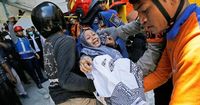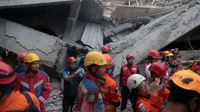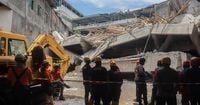Rescue teams in Sidoarjo, East Java, Indonesia, are working around the clock in a desperate bid to save dozens of students still trapped beneath the rubble of the Al-Khoziny Islamic Boarding School, which collapsed during afternoon prayers on Monday. The disaster, which struck at about 2:30 p.m. local time, has left at least six students dead and around 100 others injured, some critically, according to BBC and the Associated Press. As of Wednesday, authorities said that at least 91 students remained unaccounted for, and the operation had entered its third day amid mounting fears that the window for successful rescues was rapidly closing.
The two-storey prayer hall, a century-old structure, was packed with hundreds of mostly teenage boys—aged between 12 and 18—when it suddenly caved in. The collapse occurred as the school was undergoing an unauthorized expansion, with two additional floors being constructed atop unstable foundations. According to the disaster mitigation agency, the building simply could not bear the weight of the ongoing construction, resulting in a catastrophic failure that sent heavy concrete slabs crashing down onto the students below.
"There was confusion regarding the number of people trapped in the building, but our focus now is only on the rescue operation," Mohammad Syafii, head of Indonesia's National Search and Rescue Agency (Basarnas), told reporters, as cited by BBC. He emphasized the urgency of the situation: "We are currently racing against time because it is possible that we can still save lives of those we have detected within the golden hours." This so-called "golden timeframe"—the first 72 hours after a building collapse—offers the highest chance of survival, though officials noted that with fluids and vitamins, some may endure even longer beneath the debris.
Rescue efforts have been complicated by a number of factors. An earthquake measuring 6.5 on the Richter scale struck the region of Sumenep, about 124 miles from the school, on Tuesday, briefly halting operations and potentially packing the debris even tighter. Authorities warned that even minor vibrations could trigger further collapse or small landslides within the rubble. Mudji Irmawan, a civil engineering expert from the Sepuluh Nopember Institute of Technology, cautioned that "removing the wreckage must be done carefully to avoid destabilizing the debris and causing further collapse." Syafii added, "Shifting the slabs may also endanger the lives of survivors still trapped beneath the rubble. When we excavate, there is a risk of small landslides on both sides. With the current construction, with this rubble, even a single vibration can cause other impacts."
Given the instability, rescuers have avoided using heavy machinery and instead focused on manual digging, creating tunnel-like passages and using underground culverts with only about 60 centimeters of access. Special units from Basarnas, equipped with breathing apparatus, medical extraction gear, and sophisticated search cameras, have joined the effort. Drones and thermal detectors have also been deployed to help locate survivors. According to CNN, rescuers have managed to establish communication with several trapped individuals and have been running oxygen, water, and food through narrow gaps in the rubble to keep them alive.
Amid the chaos, stories of both tragedy and resilience have emerged. Thirteen-year-old Muhammad Rijalul Qoib described the terrifying moment the building gave way: "Many, perhaps hundreds of people, were about to pray. At that moment, I heard the sound of falling rocks. The sound continued, and it got louder and louder." He ran for the exit, only to be struck by falling debris. "I wanted to run from the prayer room and then the roof hit my face," he told Detik. With the help of another person who pointed him toward an escape route, Rijalul managed to crawl out of the rubble and survive.
Girls at the school, who were praying in another section of the building, managed to escape unharmed. Many boys, however, were less fortunate. The first confirmed fatality was Maulana Alvan Ibrahimavic, a recent elementary school graduate who had only enrolled at Al-Khoziny four months prior. Police escorted his body to his hometown in Blega district for burial on Monday night, according to local authorities.
As the rescue operation entered its third day, the mood at the site was one of anxious hope. Relatives of the missing have camped out near the school, scanning lists of names posted by the authorities and listening for any news. In one particularly harrowing account, Holy Abdullah Arif, 49, told Reuters how he rushed to the school after learning his 13-year-old nephew was among the missing. "I ran around screaming, 'Rosi! Rosi! If you can hear me and can move, get out!'" he recalled. "And then a child was screaming back from the rubble, he was stuck. I thought that was Rosi, so I asked, 'Are you Rosi?' and the child said, 'God, no, help me!'"
More than 300 rescue workers have been deployed to the scene, laboring under dangerous conditions to free those still trapped. Since Monday, at least thirteen people have been pulled from the rubble, though two died in hospital on Tuesday, and another was found dead at the scene. According to officials, six children were located alive under the debris as of Wednesday, with rescuers providing them food, water, and oxygen while they worked to reach them. Authorities initially reported only 38 missing, but that number was revised to 91 after consulting attendance lists and speaking with families.
The incident has sparked calls for greater oversight of school construction in Indonesia. The prayer hall's expansion was carried out without proper permits, and the lack of technical supervision has been cited as a contributing factor to the tragedy. Indonesian Religious Affairs Minister Nasaruddin Umar, who visited the site, told Antara news agency, "This is a wake-up call. Many Islamic schools are built through community efforts without adequate technical supervision, which poses serious risks." An official investigation into the collapse has been launched, with authorities vowing to hold those responsible to account.
Despite the challenges, rescuers remain determined to find survivors. "We hope that we can complete this operation soon," Syafii said. As the hours tick by, the people of Sidoarjo—and Indonesia as a whole—wait and hope for more miracles to emerge from the ruins of Al-Khoziny.






